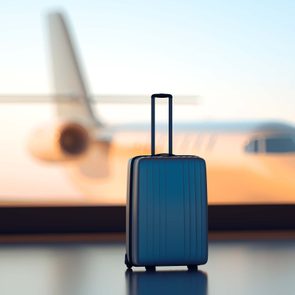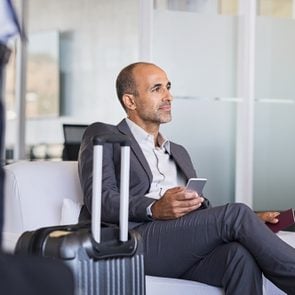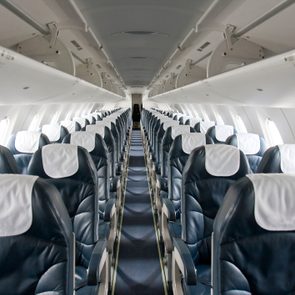This Is Why You Should Always Stay Buckled When Flying
Updated: Feb. 22, 2023

One simple safety precaution could save your head in the case of an emergency.
Whenever you board an airplane, flight attendants give you several basic instructions: put your phone on airplane mode, stow your personal items under the seat in front of you, and buckle in for the entire flight. But have you ever wondered why they ask you to do these things? Well—much like using airplane mode—it turns out staying buckled has real safety benefits. Here are the answers to every question you’ve had about airplane seatbelts, but didn’t want to ask your flight attendant.
Why should I stay buckled when flying?
In short, turbulence during a flight can pose a physical danger to unbuckled passengers. Your seatbelt will keep you from bumping your head should the plane go through any rough winds. In the words of Sarah Nelson, president of the Association of Flight Attendants, “If we were not flying a bunch of humans in this enclosed space with recirculated air miles above the earth, our preference would be that the seatbelt sign is on the entire time.”
Is turbulence dangerous?
Naturally, how much danger turbulence presents depends on the intensity of the weather causing it. Turbulence does not pose a substantial risk to the aircraft, as Brian Strzempkowski, the interim director of the Center for Aviation Studies at The Ohio State University, explains: “These planes are built strong enough that they’re able to withstand extremely bad turbulence…I realize it’s uncomfortable for passengers but the plane itself can handle it.”
However, if passengers are not strapped in, they can be at great personal risk. “The people who are not strapped in now also become projectiles themselves and can harm people when they come back down. I know plenty of flight attendants who have had career-ending injuries from turbulence,” Nelson explains.
Can airlines predict turbulence-causing weather?
Somewhat surprisingly, even the best airlines can’t always pinpoint turbulence. “While technology has improved,” Nelson says, “it is not 100% foolproof in detecting clear air conditions.”
“Turbulence can pop up anywhere,” Strzempkowski agrees. “When you go onto the National Weather Service website, and you look up their aviation forecasts, they’ll even tell you on there that these are not 100% accurate.”
How should I buckle my seatbelt during a flight?
Fortunately, if you buckle your seatbelt properly, you should have absolutely nothing to worry about when it comes to turbulence. As flight attendants instruct, you should wear your seatbelt low across your hips and it should definitely be snug for takeoff and landing.
However, during the flight, “[y]ou don’t even need to have the seatbelt on snug and tight,” according to Strzempkowski. “Just having it on loosely to give it a little restraint, if you hit a bump, you might move an inch or so, but it’ll keep you from coming out of your seat and hitting your head.”
Lastly, try to remember, flying is an extremely safe form of travel. As long as you listen to your flight attendants and buckle up, you should have nothing to worry about!
Source:






















